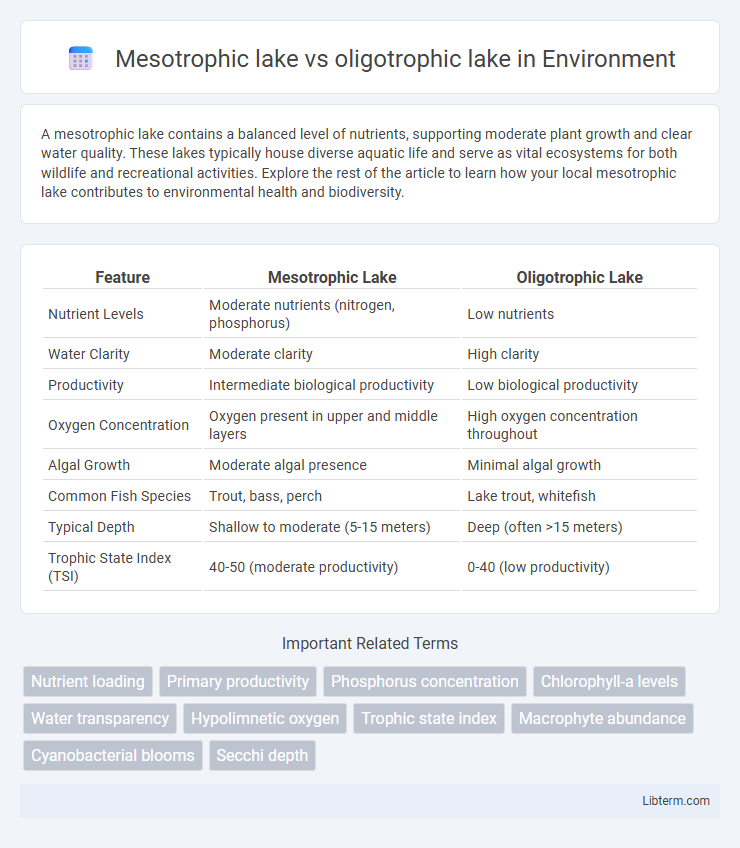A mesotrophic lake contains a balanced level of nutrients, supporting moderate plant growth and clear water quality. These lakes typically house diverse aquatic life and serve as vital ecosystems for both wildlife and recreational activities. Explore the rest of the article to learn how your local mesotrophic lake contributes to environmental health and biodiversity.
Table of Comparison
| Feature | Mesotrophic Lake | Oligotrophic Lake |
|---|---|---|
| Nutrient Levels | Moderate nutrients (nitrogen, phosphorus) | Low nutrients |
| Water Clarity | Moderate clarity | High clarity |
| Productivity | Intermediate biological productivity | Low biological productivity |
| Oxygen Concentration | Oxygen present in upper and middle layers | High oxygen concentration throughout |
| Algal Growth | Moderate algal presence | Minimal algal growth |
| Common Fish Species | Trout, bass, perch | Lake trout, whitefish |
| Typical Depth | Shallow to moderate (5-15 meters) | Deep (often >15 meters) |
| Trophic State Index (TSI) | 40-50 (moderate productivity) | 0-40 (low productivity) |
Introduction to Lake Trophic States
Mesotrophic lakes exhibit moderate nutrient levels and productivity, supporting diverse aquatic life with balanced oxygen concentrations throughout the water column. Oligotrophic lakes, characterized by low nutrient content, maintain clear water and limited biological activity but typically have high oxygen levels, especially in deeper zones. These trophic states reflect the ecological health and nutrient dynamics critical for managing freshwater ecosystems.
Defining Mesotrophic and Oligotrophic Lakes
Mesotrophic lakes exhibit moderate nutrient levels and biological productivity, often showing balanced oxygen concentrations throughout the water column, supporting diverse aquatic ecosystems. Oligotrophic lakes contain low nutrient concentrations, resulting in low primary productivity and typically clear water with high oxygen levels, especially in deeper areas. The distinction between these lake types lies primarily in nutrient availability, water clarity, and resulting ecological characteristics.
Physical Characteristics Comparison
Mesotrophic lakes exhibit moderate nutrient levels, resulting in balanced productivity and water clarity, often accompanied by average depth and well-oxygenated conditions throughout the water column. In contrast, oligotrophic lakes are characterized by low nutrient concentrations, high water clarity, greater depth, and oxygen-rich environments that support limited aquatic plant growth. The physical distinction primarily lies in mesotrophic lakes' intermediate trophic state versus the nutrient-poor and deeper profiles typical of oligotrophic lakes.
Water Clarity and Color Differences
Mesotrophic lakes exhibit moderate water clarity with greenish hues caused by an intermediate concentration of phytoplankton, whereas oligotrophic lakes feature high water clarity and a distinctive blue or blue-green color due to low nutrient levels and minimal algal growth. The increased nutrient availability in mesotrophic lakes promotes more algal biomass, reducing transparency compared to the clear, nutrient-poor waters of oligotrophic lakes. Light penetration in oligotrophic lakes typically extends deeper, supporting diverse aquatic life adapted to clearer water, unlike the murkier conditions in mesotrophic environments.
Nutrient Levels and Sources
Mesotrophic lakes exhibit moderate nutrient levels, particularly phosphorus and nitrogen, supporting balanced aquatic plant growth and fish populations. These nutrients often originate from natural runoff, decaying organic matter, and controlled agricultural inputs. In contrast, oligotrophic lakes have low nutrient concentrations, primarily due to limited external nutrient sources and minimal organic material, resulting in clear water and low biological productivity.
Biodiversity and Aquatic Life
Mesotrophic lakes exhibit moderate nutrient levels that support diverse aquatic plant species and a balanced fish population, fostering rich biodiversity compared to oligotrophic lakes. Oligotrophic lakes, characterized by low nutrient concentrations and high oxygen levels, sustain fewer but specialized aquatic organisms adapted to nutrient-poor conditions. Biodiversity in mesotrophic lakes typically surpasses that in oligotrophic lakes due to enhanced primary productivity and varied habitats within the ecosystem.
Ecological Functions and Productivity
Mesotrophic lakes exhibit moderate nutrient levels, supporting balanced primary productivity and diverse aquatic life, while oligotrophic lakes possess low nutrient concentrations resulting in limited algae growth and clearer water. The ecological functions of mesotrophic lakes facilitate nutrient cycling and habitat provision for a wide range of species, whereas oligotrophic lakes maintain high oxygen levels and support species adapted to nutrient-poor conditions. Productivity in mesotrophic lakes peaks at intermediate levels, fostering a dynamic food web, contrasting with oligotrophic lakes' low productivity that sustains fewer but specialized organisms.
Human Impact on Each Lake Type
Mesotrophic lakes, characterized by moderate nutrient levels, often face increased eutrophication due to agricultural runoff and urbanization, leading to algal blooms and decreased water quality. Oligotrophic lakes, with their low nutrient content and clear waters, are particularly sensitive to human impact such as acid rain and deforestation, which can disrupt their fragile ecosystems and reduce oxygen levels. Both lake types require targeted management practices to mitigate human-induced nutrient loading and preserve aquatic biodiversity.
Recreational and Economic Significance
Mesotrophic lakes, characterized by moderate nutrient levels and balanced aquatic ecosystems, support diverse recreational activities such as fishing, boating, and swimming, attracting tourism that boosts local economies. Oligotrophic lakes, with their low nutrient content and clear waters, offer high-value recreational opportunities like trout fishing, diving, and nature observation, often leading to premium real estate development and eco-tourism revenue. Both lake types contribute significantly to regional economic growth through sustainable recreational use and associated service industries.
Conservation and Management Strategies
Mesotrophic lakes, characterized by moderate nutrient levels and balanced productivity, require conservation strategies focusing on preventing nutrient overload through controlled agricultural runoff and enhanced buffer zones. Oligotrophic lakes, with low nutrient concentrations and high oxygen levels, demand management practices aimed at preserving water clarity and minimizing anthropogenic impacts such as urban development and recreational pressure. Both lake types benefit from adaptive monitoring programs that track nutrient inputs, biological indicators, and water quality to inform targeted restoration and protection efforts.
Mesotrophic lake Infographic

 libterm.com
libterm.com